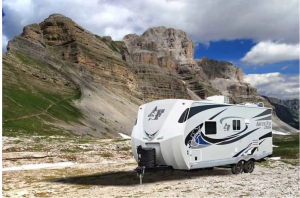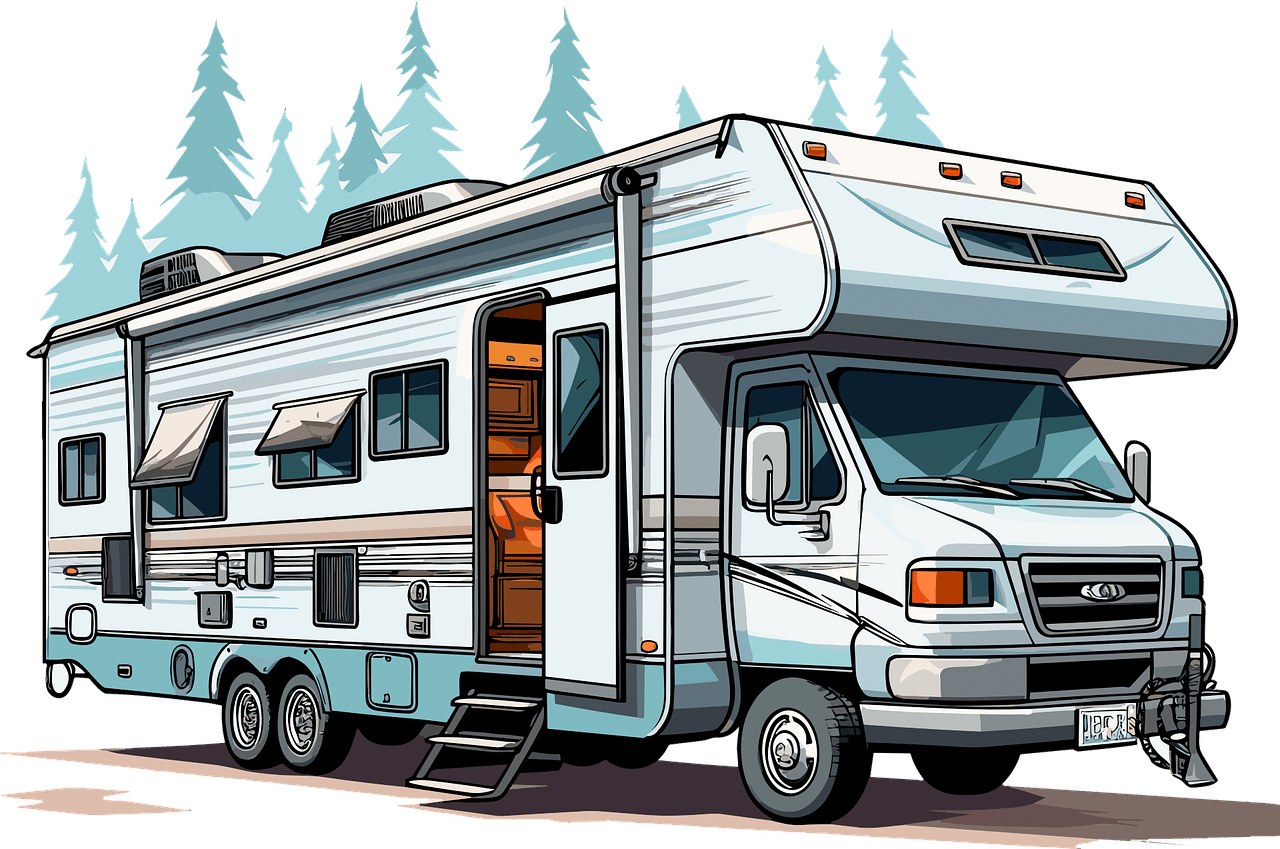It’s vital for RV owners to know how to combat mould in their RVs. It is a common problem for RV owners, especially those who live in humid or damp areas. It can cause serious health issues, such as respiratory problems, allergies, and skin irritation. Mould can also damage the structure of your RV and cause unpleasant odours. It thrives in damp, warm environments, making RVs the perfect breeding ground for this pesky fungus. You’ll know that mould is lurking inside your RV by the musty smell that hits your nostrils the moment you open the door. Then you’ll realise that immediate action needs to be taken! If you’re unsure whether mould is present in your RV, then you can purchase a toxic mould kit to check it out.
Identifying Signs of Mould
As it can take hold quickly, mould can be a serious problem in RVs, so it’s really important to be vigilant and root it out straight away. You’ll find that there are certain places where it lurks in your RV, so these are the key places to check:
- seals around windows and roof hatches. Take your time inspecting these, checking for any signs of wear and tear and leaks. Any moisture seeping in from outdoors is going to cause trouble. If you find any problems, then it’s imperative that you address them right away to prevent mould growth.
- empty out your cupboards and check in there, especially right at the back near the RV walls. Still, moist air tends to collect in RV cupboards when the doors are kept closed.
- check any seals around the ceiling and upper corners of your RV and see if they feel damp to your fingertips. At the first sign of a leak- get onto it!
- check hatches, pop-up roofs and sliders: these can all be culprits for allowing moisture to enter your RV, so check them thoroughly.
- Air vents and air-conditioning vents. These can easily can clogged up with organic matter from outside and therefore stop functioning properly. This means that moisture can’t escape from your RV effectively. Bad news!! Check for leaves, birds’ nests etc and clear them out thoroughly.
- leaks: leaks can be quietly but massively destructive to your RV, especially if they occur while your rig is in storage. Before you head off for your first rving trip of the year, check for leaks. Look at all taps, drains, pipes. Get in under the sink with a flashlight and make sure that everything is absolutely watertight. Check for any signs of damage or corrosion. Run your fingers around any pipework that you can’t see for any sign of damp. If you find anything, then fix right away.
- check around the shower and the cooking areas, as these are where the most moisture is produced inside your RV. Remember to also check and clean out the extractor fans and outlets in your kitchen and bathroom areas.
- Lift out bedding and mattresses from your sleeping areas and check for signs of mould. Enclosed bunk areas are prime breeding ground for mould spores, as they thrive on the warmth and humidity of our sleeping, breathing bodies. Turn over your mattresses and check underneath.
- Check your curtains, screens and window blinds for the black specks signs of mould growth. Condensation from the windows can gather on window dressings and mould can begin to take hold there.
Causes of Mould in RVs
Moisture and Condensation
Moisture and condensation are the primary causes of mould growth in RVs. When the air inside the RV is warmer than the air outside, it can cause condensation to form on the windows and walls. This moisture can lead to mould growth if it is not properly addressed.
Combat Mould With Good Ventilation
Good ventilation in your RV is essential to prevent mould growth. Whenever possible, open the windows and vents to allow air to circulate. At night time, try to leave the windows open a crack to allow warmth breath and sweat to escape. It’s a good idea to use a fan to keep the air circulating.
Extract Moisture From Cooking
Remember to use your extractor fan when you’re cooking. If you can, leave the doors and windows open to let the steam out of the RV at the same time. Even better, cook outdoors, or under your awning. You could use a portable barbecue That way, you’ll have no worries about causing any condensation from cooking inside your RV.
Combat Mould by Using Fan Heaters
Use the heaters in your RV to dry out the air. Set your heaters on a low setting and let them work away quietly in the background to keep the moisture levels low. Even if you just switch them on periodically, when moisture-producing activities are happening, they will help.
Use Dehumidifiers
These units draw in the moist air from the atmosphere and cools it, collecting it in a tank which you’ll need to empty. They then blow out warm, dry air back into your RV. A popular choice with RVers is the Whisper-Quiet Eva-Dry
Combat Mould With Moisture Absorbers
You will find that using moisture absorbers in key areas of your RV is very helpful. Closed storage cupboards are a great feeding ground for mould to develop, so it’s a great idea to open the doors to allow air to circulate inside. Place moisture absorbers at the backs of these cupboards, and try to keep things away from the RV walls as much as you can. Place them under the sink, too, as they really help to pull moisture out of the air. Many seasoned RVers advise putting these moisture absorbers at the back of your food storage cupboards as well.
Brands recommended by experienced RVers are: Damp Rid and Star Brite Nos Guard Mildew Odor Control Bags.
Look for Signs of Mould Under The Mattress
Obviously, with all the breathing and sweating that happens in sleeping areas, under the mattress is a prime, warm breeding ground for the dreaded mould. When you can, haul those mattresses and bedding outside on warm days and give them a good airing.
To combat the growth of mould under mattresses yoga mats are effective. Another well-known solution is to place rubber floor tiles under your mattress to create a barrier under your mattress, but on top of your bed. Many seasoned RV experts recommend using DRY-Mat Ventilation and anti-condensation Mattress Pad
Dry Wet Towels and Laundry Outside
As much as is possible, dry your wet things outside to combat the growth of mould in your RV. You can buy a simple washing line to rig up under your awning where you can peg out your wet clothes and towels. You may not be able to dry them completely out there, but at least the majority of the moisture should be able to drip out of the materials.
Make Sure Everything’s Dry Before you Store it Away
Unless you take all your RV vacations in the desert, there are going to be those days when you’ve got to pack up your awning or pop-up canvas top when it’s still wet, because it’s time to move on. Obviously, this just can’t be helped. Just be mindful of trying to open everything out and get it thoroughly dried as soon as possible.

Don’t Feed Mould
As mould loves to grow on damp, organic matter, it makes sense to keep all your surfaces clean and dry. In order to combat the growth of mould in your RV, wipe down surfaces with an anti-mould spray and let them dry. Use a cloth to wipe condensation from the insides of your windows and peg it outside to dry.
Mould Removal Products
If you spot areas of mould in your RV, go in for the attack!
There are many products to use to combat the dreaded spores. White vinegar is a natural mould killer, or you may wish to try tea tree oil, hydrogen peroxide, 3% hydrogen peroxide, distilled ethanol, grapefruit seed extract or baking soda. Many seasoned RVers recommend these mould and mildew removers.
White vinegar is more acidic than regular vinegar and is more effective in killing mould. Tea tree oil is a natural antifungal agent. Hydrogen peroxide is a natural alternative to bleach and is effective in removing mould stains. 3% hydrogen peroxide is safe to use on most surfaces. Distilled ethanol is a natural disinfectant. Grapefruit seed extract is a natural antifungal agent and is effective in killing mould. Baking soda is a natural abrasive and is effective in removing mould stains.
Off-Season Care
During the off-season, take extra care to combat mould growth in your RV. Here are some tips to help keep your RV mould-free:
- Clean and dry your RV thoroughly before storing it for the off-season.
- Use a dehumidifier to keep the humidity level low and prevent mould growth.
- Keep your RV well-ventilated by opening windows and roof vents to allow fresh air to circulate and reduce moisture levels.
- Use moisture absorbers throughout your RV to help keep moisture at bay.
- Consider adding insulation to your camper to help regulate temperature and reduce moisture.
- Seal up any cracks in your bathroom to prevent moisture from seeping in.
- Wipe down all hard surfaces in your RV with a disinfectant to help prevent mould growth.
By following these tips, you can help prevent mould growth in your RV and keep it in top condition for your next adventure.
Conclusion
In conclusion, preventing and combating mould in your RV is crucial for a pleasant and healthy travel experience. The first step is to identify and eliminate any sources of moisture, such as leaks or condensation. Regularly cleaning and airing out your RV can also help prevent mould growth.
Using a dehumidifier or moisture-absorbing products and maintaining proper ventilation can significantly reduce the humidity levels in your RV. It is also important to keep an eye on the humidity levels and temperature using a hygrometer to ensure they are within the recommended range.
If you do find mould in your RV, it is important to address it promptly. You can use a variety of cleaning solutions and methods to remove the mould. Be sure to wear protective gear, such as gloves and a mask, when cleaning to avoid inhaling mould spores.
Overall, by taking proactive measures to prevent and combat mould in your RV, you can ensure a safe and enjoyable travel experience. Happy RVing, Adventurers!
Affiliate Disclosure: This article contains affiliate links. Should you buy anything as a result of clicking on any of my links, then I will receive a small commission. This will be at no extra cost to you, but will help to fund my expensive coffee habit.

